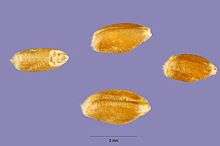Triticum carthlicum
| Persian wheat | |
|---|---|
 | |
| Scientific classification | |
| Kingdom: | Plantae |
| (unranked): | Angiosperms |
| (unranked): | Monocots |
| (unranked): | Commelinids |
| Order: | Poales |
| Family: | Poaceae |
| Subfamily: | Pooideae |
| Tribe: | Triticeae |
| Genus: | Triticum |
| Species: | T. carthlicum |
| Binomial name | |
| Triticum carthlicum Nevski, 1934[1] | |
Triticum carthlicum Nevski, 1934,[1] the Persian wheat,[2] is a tetraploid wheat.[3]
References
- 1 2 "Triticum carthlicum Nevski". The Plant List.
- ↑ "Triticum carthlicum". Natural Resources Conservation Service PLANTS Database. USDA. Retrieved 16 December 2015.
- ↑ Ping-ping Zhuang; Qin-ce Ren; Wei Li; Guo-Yue Chen (2011). "Genetic Diversity of Persian Wheat (Triticum turgidum ssp. carthlicum) Accessions by EST-SSR Markers" (PDF). American Journal of Biochemistry and Molecular Biology. 1 (2): 223–230. doi:10.3923/ajbmb.2011.223.230.
Bibliography
- E. R. Kerber; V. M. Bendelow (1977). "The Role of Triticum carthlicum in the Origin of Bread Wheat Based on Comparative Milling and Baking Properties". Canadian Journal of Plant Science. 57 (2): 367–373. doi:10.4141/cjps77-053.
- W. Bushuk; E. R. Kerber (1978). "The Role of Triticum carthlicum in the Origin of Bread Wheat Based on Gliadin Electrophoregrams". Canadian Journal of Plant Science. 58 (4): 1019–1024. doi:10.4141/cjps78-155.
This article is issued from Wikipedia - version of the 6/6/2016. The text is available under the Creative Commons Attribution/Share Alike but additional terms may apply for the media files.